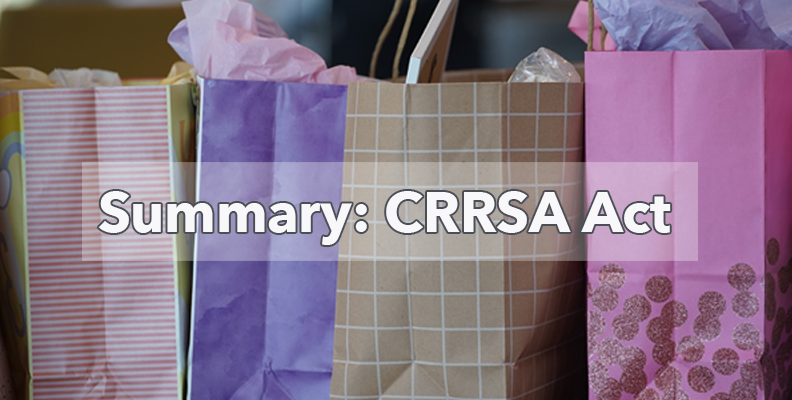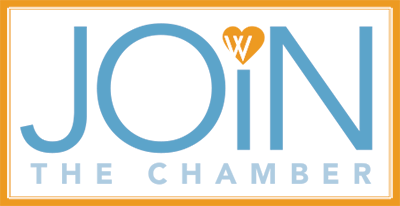Coronavirus Response and Relief Supplemental Appropriations Act of 2021
The Coronavirus Response and Relief Supplemental Appropriations Act of 2021 (CRRSAA) — which was signed into law on December 27, 2020, as part of a larger government appropriations bill — provides more assistance to individuals and businesses harmed by the impact of the coronavirus pandemic. The CRRSAA provides direct payments to individuals, revises key aspects of the CARES Act to provide more flexibility to businesses and offers enhanced federal unemployment benefits.

What does it mean for small businesses?
Reopening and Revisions: Paycheck Protection Program
The PPP has been reopened so more businesses can apply for the first time, and some companies can apply for a “second-draw” PPP loan. The bill also expands the types of expenses that can be paid for with PPP funds and makes forgiveness easier to obtain for businesses that took out loans worth less than $150,000. Applications for new and second-draw PPP loans are open until March 31, 2021, or until funds are exhausted.
The second loans will be limited to those with fewer than 300 employees that have seen drops of at least 25% of their revenue during the first, second, or third quarter of 2020. It also reduces the amount a borrower can receive from $10 million to $2 million, gives businesses more flexibility on how they spend the money and simplifies the forgiveness process for loans under $150,000.
It carves out $12 billion for minority-owned businesses.
It expands eligibility to more nonprofits including 501(c)(6)’s as well as local newspapers, TV, and radio broadcasters.
Changes to Business Taxes
The CRRSAA makes PPP loans non-taxable and ensures that the majority of business expenses paid for with PPP loans are also not taxable. The legislation also makes businesses eligible to receive both PPP loans and the Employee Retention Tax Credit (ERTC), whereas they were not eligible under the original CARES Act.
Reopening of the EIDL Grant Program
The bill allocates more money for the Economic Injury Disaster Loan (EIDL) grant program that had been expanded in the CARES Act. This will allow some businesses to receive up to $10,000 in EIDL grants.
Stimulus Checks
The package sends direct stimulus payments of $600 to individuals. Eligible families will receive an additional $600 per child — which is $100 more than Congress gave families in the first round of relief last spring.
The payments start phasing out for individuals with adjusted gross incomes of more than $75,000, and those making more than $99,000 will not receive anything. The income thresholds are doubled for couples.
The amounts will be based on 2019 incomes. Those who filed their 2019 tax returns will receive their money automatically, as well as Social Security recipients and those who uploaded their bank account information using the IRS’s online portal to receive their first payments.
Undocumented immigrants who don’t have Social Security numbers remain ineligible for the payments. But in a change from the first round, their spouses and children are now eligible as long as they have Social Security numbers.
NOTE: The proposed $2,000 stimulus check for citizens is still being debated. However, the $600 payment is going forward and many have already seen direct deposits into their accounts.
Unemployment Benefits
Those currently unemployed will receive a $300 weekly federal enhancement in benefit through March 14.
The package also extends — by 11 weeks — two other pandemic unemployment programs that were created in the CARES Act in March which were set to expire on 12/31/2020.
The Pandemic Unemployment Assistance program initially expanded jobless benefits to gig workers, freelancers, independent contractors, the self-employed, and certain people affected by the coronavirus for up to 39 weeks. The Pandemic Emergency Unemployment Compensation program provided an additional 13 weeks of payments to those who exhaust their regular state benefits.
Both programs will now close to new applicants on March 14, but continue through April 5 for existing claimants who have not yet reached the maximum number of weeks.
The measure also provides a federally funded $100 per week additional benefit to those who have at least $5,000 in annual self-employment income but are disqualified from receiving Pandemic Unemployment Assistance because they are eligible for regular state unemployment benefits.
In addition, the package gives states the authority to waive overpayments in cases where the claimant is not at fault.
Grants for Theaters and Other Live Venues
The package creates a $15 billion grant program for live venues, theaters, and museum operators that have lost at least 25% of their revenues.
The initial grant can total up to $10 million per eligible business. A second grant, worth half the amount of the first, may also be available. The money is for specified expenses such as payroll costs, rent, utilities, and PPE.
During the first 14 days of the program’s implementation, grants will be awarded to those who have faced 90% revenue losses. After those two weeks, venues who have experienced at least 70% revenue losses will be eligible during the next 14 days. After the first month of the program, other eligible businesses may receive grants.
Funding for Schools and Child Care
The Act provides $82 billion in aid for K-12 schools and colleges. An additional $10 billion is included to support child care providers that have struggled because of the pandemic.
Rental Assistance
The Act extends — until January 31 — the eviction protection that was set to expire at the end of the year. It also provides $25 billion in rental assistance for individuals who lost their sources of income during the pandemic.
Nutrition Assistance
The package raises SNAP benefits by 15% for six months but does not expand eligibility.
Vaccine and Hospital Funding
The Act provides $20 billion for the purchase of vaccines so they can be available at no charge for those who need it, as well as another $8 billion for vaccine distribution.
It also gives states $20 billion to assist with testing.
And it adds $3 billion to the $175 billion fund for hospitals and health care providers for reimbursement of health care-related expenses or lost revenue resulting from the pandemic.
Other Key Additions
Broadband Access
The measure contains $7 billion to increase access to broadband Internet, including a new Emergency Broadband Benefit that will help millions of students’ families and unemployed workers afford the broadband they need during the pandemic.
Transportation Aid
Lawmakers also agreed to provide $45 billion in transportation-related assistance, including:
$16 billion for airlines to pay the salaries of workers and contractors;
$14 billion for mass transit agencies;
$10 billion for highways; and
$1 billion for Amtrak.
Agriculture
$13 billion will support farmers and agriculture, including money under the Coronavirus Food Assistance Program, for growers, livestock, dairy, and poultry producers.

